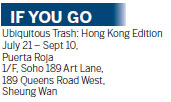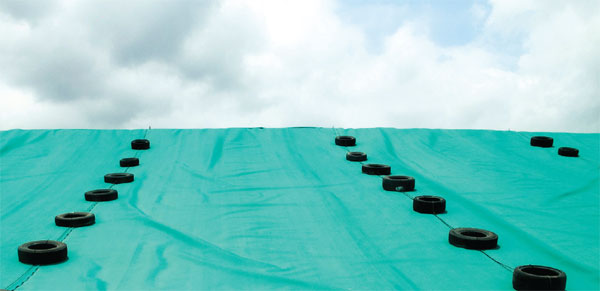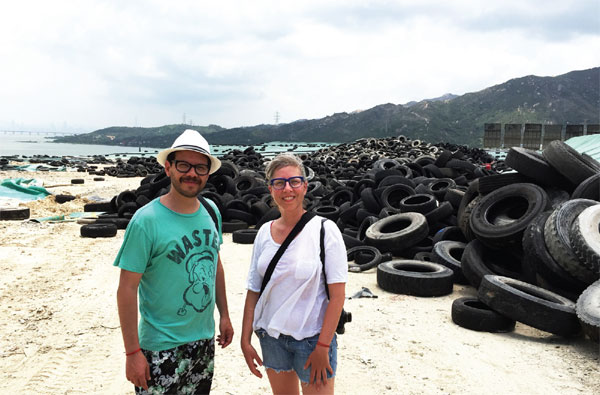When junk is food for thought
Updated: 2016-07-15 09:05
(HK Edition)
|
|||||||||
Even as garbage piles up, choking vast swathes of HK's beaches, a Mexican art collective is trying to find meaning in all that trash.
More than 90 bottle caps carrying the image of Nicholas Tse Ting-fung, the famous Hong Kong actor and singer, were lined up on the wall of Connecting Space gallery in North Point. Discarded from bottles of a soft drink brand manufactured in the Chinese mainland, these had washed up on a beach in the New Territories. IlanaBoltvinikand Rodrigo Vias, who together make the Mexican art collective TRES, picked up these bottle caps mindlessly chucked by consumers and turned them into art. Their show, called Ubiquitous Trash: Hong Kong Edition, has just concluded at Connecting Space, but will open again elsewhere in the city in the coming months.
Earlier, TRES had put together a similar artistic experiment in their native Mexico City. Their objective is to explore the relationship between public space and garbage through art. Elements from science, anthropology and archaeology also figure in their work. The proposal for Ubiquitous Trash won the Wyng Masters Award 2014-15, administered by the Hong Kong-based Wyng Foundation.
Last July, Boltvinik and Vias spent 20 days in Hong Kong, visiting local landfill sites and refuse transfer stations. They also collected huge amounts of trash and clicked over 6,000 photos of trash accumulating in different parts of the city. Having spent a year archiving the material they had collected, besides studying and analyzing it in great detail, TRES was back in Hong Kong earlier this month with a book and an exhibition, ready to share their research findings with concerned citizens.
The duo says they find trash - which people produce everyday, as a matter of routine - inspiring. Their obsession with garbage has taken Boltvinik and Vias all over the world. They say a city's trash could be a "fascinating tool" to understand its social life."We would say we are scavengers, art-based researchers and archeologists of everyday life," is how the pair would describe themselves.
Boltvinik says she is thrilled by the sight of trash on the street. "Stories and information about a city's people are hidden behind every piece of trash," she says, and Hong Kong was no exception. During their 20 days spent scavenging in Hong Kong, TRES found people discarded more plastic bottles and Styrofoam containers on a daily basis than in most other cities. "Maybe it is because of the hot weather here and also perhaps because people don't have enough time to have a meal sitting down in an eatery. They are always opting for takeouts, hence the extensive use of Styrofoam containers."
Eyesore on sea shore
In the last few weeks, trash washing up on Hong Kong's shores has been much in news, catching the attention of the international media. The volume of garbage choking Hong Kong's coastline is said to be unprecedented. "But the condition last year was already the worst we've seen," says Boltvinik. "As Hong Kong is one of the world's biggest port cities, we believe it makes for a representative case study," she said, citing her reasons for choosing Hong Kong for the project.
They were taken aback by the amazing volume and diverse categories of garbage piled up on Hong Kong's beaches. In the beaches near Tong Fuk village and the south of Lantau Island, they found piles of garbage containing discarded fishing equipment, floaters, lighters, plastic bags, bottles and bottle caps. "We've never seen that kind of beaches in our lives," said Boltvinik, shrugging her shoulders.
Then this was not perhaps totally unexpected in a city where consumer culture prevails. As Vias says, capitalist societies encourage accelerated consumption, trigger a growing desire to run out of resources and produce endless garbage as a result. Ironically, however much people would want to get rid of garbage by consigning it to remote places, putting it out of sight, there is no wishing it away by turning one's back on it. In a photograph they took a landfill in Tuen Mun doesn't look like an eyesore because the mountain loads of waste that went into it are covered by a green nylon netting.
Instead of sweeping the dirt under the carpet, TRES would like to encourage people to engage more with the objects around them, build relationships with what they are about to discard, if possible. They are looking to inspire a more sensitive attitude towards waste through their work, and also their lifestyle practices.
Boltvinik, for example, said she would continue to wear the clothes she was wearing until they were full of holes, for "it's not just a blouse I bought in Mexico City three years ago, but a part of my life I was wearing it in certain significant moments in my life."
A global scavenger hunt has taken Boltvinik and Vias from Mexico City to Manchester and now to Hong Kong. They are headed to Australia next, to find out more about the way people treat the stuff they don't want any more Down Under.
Kathy Zhang contributed to the story.
|
Mountains of waste lie underneath green nylon nettings in a landfill in Tuen Mun in this image from Ubiquitous Trash: Hong Kong Edition. |
|
The Mexican art collective TRES members Rodrigo Viñas (left) and Ilana Boltvinik take a photo break in between collecting trash in a landfi ll in Hong Kong. Photos Provided To China Daily |
|
A selection of the exhibits from Ubiquitous Trash: Hong Kong Edition, a show meant to encourage viewers to take a second glance at the stuff they routinely discard. |

(HK Edition 07/15/2016 page8)


